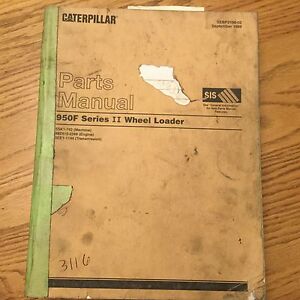CATERPILLAR 950F Series II Wheel Loader PARTS MANUAL XEBP8312-01 4DJ 2000-Up XEBP7312-01, dated September 1994. 4DJ2000-Up (Vehicle), 1 CK 7300-Up (Engine), 5JX1-Up (Transmission). Soiling to cover, but inside in very good condition. Buy and Download this COMPLETE Service and Repair Manual. It covers every single detail on your Caterpillar Cat 950F Series II Wheel Loader Operation & Maintenance.This is the authentic factory service manual from Caterpillar which covers every repair and service procedure. Engine:- All engines included Years:- All years included Filesize:- 22 MB Model Specific Continue reading.
The following instructions are for 938F, IT38F, 950F Series II, 960F, 966F Series II and 970F. For specific part numbers and specific illustrations, refer to the Custom Parts Manual, SEBC1243. Refer to 'Installation of Air Conditioner Lines and Components' which is included in this publication.
Usage:
Caterpillar cat 950f 950 series ii wheel loader parts book manual 5sk. Caterpillar service shop manual- 950f& 950f series 2 wheel loader- 2001 serial numbers: 7zf 1& up/ 6yg 1& up/ 4dj 1& up/ 5sk 1& up/. More 8tk 1& up/ 2lm 1& up sections included in this manual- speci fi c ati o ns- torque specs. 3116& 31 26 specification s- 3114. 3116, 3126 engines- basic engine components system operation testing& adjusting- 3114. 3116, 3126 engines.
 950F II2LM
950F II2LM| Illustration 1 | g00713835 |
Location of the Main Relief Valve | |
The main relief valve limits the pressure from the implement pump to the main control valve.
When the pressure at the inlet to the main control valve exceeds the pressure setting of the main relief valve, the main relief valve opens. The excess hydraulic oil then flows through the main relief valve to the hydraulic oil tank.
Note: The pressure setting of the main relief valve on standard machines is 20700 ± 340 kPa (3000 ± 50 psi). The pressure setting of the main relief valve on logging machines is 19000 +500 -200 kPa (2750 +73 -30 psi).
| Illustration 2 | g00712941 |
(1) Inlet. (2) Valve. (3) Seat. (4) Pilot Valve. (5) Locknut. (6) Plunger. (7) Outlets. (8) Passage. (9) Spring. (10) Spring. (11) Spacer. | |
Hydraulic oil flows into inlet (1), through the orifice in the center of valve (2), and into the chamber for spring (9). The oil in the spring chamber contacts valve (4). Seat (3) can not move. Seat (3) is pressed into the valve body.
When the pressure of the oil in the circuit is less than the relief valve setting, the force of spring (10) on valve (4) keeps the main relief valve closed.

Caterpillar 950f Service Manual Pdf
If the oil pressure in inlet (1) exceeds the relief valve setting, the oil pressure overcomes the force of spring (10). This causes valve (4) to move down. The oil in the chamber for spring (9) flows through the hole in seat (3). The oil then flows through passage (8) to the hydraulic oil tank.
When valve (4) opens, the pressure of the oil in the chamber for spring (9) decreases. The force against the bottom of valve (2) also decreases. The pressure of the oil at inlet (1) moves valve (2) downward. Oil can then flow through outlets (7), and back to the hydraulic oil tank.

Valve (2) remains down until valve (4) closes. Valve (4) will close when the pressure at inlet (1) drops below the pressure setting of the relief valve.
The pressure setting of the main relief valve can be adjusted by locknut (5), plunger (6) and spacer (11) .
Reference: For more information on testing and adjusting the pressure setting of the main relief valve, refer to the Service Manual module for Testing and Adjusting, 'Relief Valve (Main) - Test and Adjust' for the machine that is being serviced.
Cat 950f Ii
Usage:
| NOTICE |
|---|
Care must be taken to ensure that fluids are contained during performance of inspection, maintenance, testing, adjusting and repair of the product. Be prepared to collect the fluid with suitable containers before opening any compartment or disassembling any component containing fluids. Refer to Special Publication, NENG2500, 'Caterpillar Tools and Shop Products Guide' for tools and supplies suitable to collect and contain fluids on Caterpillar products. Dispose of all fluids according to local regulations and mandates. |
| Illustration 1 | g00813398 |
The hydraulic oil filters are located in the hydraulic oil tank. The hydraulic oil tank is located behind the platform on the right side of the machine.
- Remove the three bolts (2) and swing the platform (1) away from the machine.
- Remove the four bolts (3) from each of the covers (4). Remove both of the covers.
- Remove the filter elements. Discard the old elements.
- Clean the covers. Inspect the condition of the seals. Replace the seals, if necessary.
- Install new filter elements and install the covers. Tighten the bolts to
58 ± 4 N·m (42.8 ± 2.9 lb ft) . - Check the level of the hydraulic oil tank. Add oil, if necessary.
- Close the platform and install the three bolts.